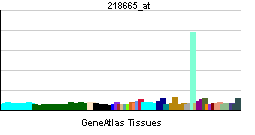FZD4
| Frizzled homolog 4 (Drosophila) | |||||||||||
|---|---|---|---|---|---|---|---|---|---|---|---|
| Identifiers | |||||||||||
| Symbols | FZD4 ; EVR1; FEVR; FZD4S; Fz-4; FzE4; GPCR; MGC34390 | ||||||||||
| External IDs | Template:OMIM5 Template:MGI HomoloGene: 7325 | ||||||||||
| |||||||||||
| RNA expression pattern | |||||||||||
 | |||||||||||
| More reference expression data | |||||||||||
| Orthologs | |||||||||||
| Template:GNF Ortholog box | |||||||||||
| Species | Human | Mouse | |||||||||
| Entrez | n/a | n/a | |||||||||
| Ensembl | n/a | n/a | |||||||||
| UniProt | n/a | n/a | |||||||||
| RefSeq (mRNA) | n/a | n/a | |||||||||
| RefSeq (protein) | n/a | n/a | |||||||||
| Location (UCSC) | n/a | n/a | |||||||||
| PubMed search | n/a | n/a | |||||||||
Frizzled homolog 4 (Drosophila), also known as FZD4, is a human gene.[1] FZD4 has also been designated as CD344 (cluster of differentiation 344).
This gene is a member of the frizzled gene family. Members of this family encode seven-transmembrane domain proteins that are receptors for the Wingless type MMTV integration site family of signaling proteins. Most frizzled receptors are coupled to the beta-catenin canonical signaling pathway. This protein may play a role as a positive regulator of the Wingless type MMTV integration site signaling pathway. A transcript variant retaining intronic sequence and encoding a shorter isoform has been described, however, its expression is not supported by other experimental evidence.[1]
See also
References
Further reading
- Li Y, Fuhrmann C, Schwinger E; et al. (1992). "The gene for autosomal dominant familial exudative vitreoretinopathy (Criswick-Schepens) on the long arm of chromosome 11". Am. J. Ophthalmol. 113 (6): 712–3. PMID 1598965.
- Tanaka S, Akiyoshi T, Mori M; et al. (1998). "A novel frizzled gene identified in human esophageal carcinoma mediates APC/beta-catenin signals". Proc. Natl. Acad. Sci. U.S.A. 95 (17): 10164–9. PMID 9707618.
- Kirikoshi H, Sagara N, Koike J; et al. (1999). "Molecular cloning and characterization of human Frizzled-4 on chromosome 11q14-q21". Biochem. Biophys. Res. Commun. 264 (3): 955–61. doi:10.1006/bbrc.1999.1612. PMID 10544037.
- Sagara N, Kirikoshi H, Terasaki H; et al. (2001). "FZD4S, a splicing variant of frizzled-4, encodes a soluble-type positive regulator of the WNT signaling pathway". Biochem. Biophys. Res. Commun. 282 (3): 750–6. doi:10.1006/bbrc.2001.4634. PMID 11401527.
- Takeda S, Kadowaki S, Haga T; et al. (2002). "Identification of G protein-coupled receptor genes from the human genome sequence". FEBS Lett. 520 (1–3): 97–101. PMID 12044878.
- Hering H, Sheng M (2002). "Direct interaction of Frizzled-1, -2, -4, and -7 with PDZ domains of PSD-95". FEBS Lett. 521 (1–3): 185–9. PMID 12067714.
- Robitaille J, MacDonald ML, Kaykas A; et al. (2002). "Mutant frizzled-4 disrupts retinal angiogenesis in familial exudative vitreoretinopathy". Nat. Genet. 32 (2): 326–30. doi:10.1038/ng957. PMID 12172548.
- Strausberg RL, Feingold EA, Grouse LH; et al. (2003). "Generation and initial analysis of more than 15,000 full-length human and mouse cDNA sequences". Proc. Natl. Acad. Sci. U.S.A. 99 (26): 16899–903. doi:10.1073/pnas.242603899. PMID 12477932.
- Chen W, ten Berge D, Brown J; et al. (2003). "Dishevelled 2 recruits beta-arrestin 2 to mediate Wnt5A-stimulated endocytosis of Frizzled 4". Science. 301 (5638): 1391–4. doi:10.1126/science.1082808. PMID 12958364.
- Toomes C, Downey LM, Bottomley HM; et al. (2004). "Identification of a fourth locus (EVR4) for familial exudative vitreoretinopathy (FEVR)". Mol. Vis. 10: 37–42. PMID 14737064.
- Toomes C, Bottomley HM, Jackson RM; et al. (2004). "Mutations in LRP5 or FZD4 underlie the common familial exudative vitreoretinopathy locus on chromosome 11q". Am. J. Hum. Genet. 74 (4): 721–30. doi:10.1086/383202. PMID 15024691.
- Yao R, Natsume Y, Noda T (2005). "MAGI-3 is involved in the regulation of the JNK signaling pathway as a scaffold protein for frizzled and Ltap". Oncogene. 23 (36): 6023–30. doi:10.1038/sj.onc.1207817. PMID 15195140.
- Toomes C, Bottomley HM, Scott S; et al. (2004). "Spectrum and frequency of FZD4 mutations in familial exudative vitreoretinopathy". Invest. Ophthalmol. Vis. Sci. 45 (7): 2083–90. PMID 15223780.
- Omoto S, Hayashi T, Kitahara K; et al. (2004). "Autosomal dominant familial exudative vitreoretinopathy in two Japanese families with FZD4 mutations (H69Y and C181R)". Ophthalmic Genet. 25 (2): 81–90. doi:10.1080/13816810490514270. PMID 15370539.
- Yoshida S, Arita R, Yoshida A; et al. (2004). "Novel mutation in FZD4 gene in a Japanese pedigree with familial exudative vitreoretinopathy". Am. J. Ophthalmol. 138 (4): 670–1. doi:10.1016/j.ajo.2004.05.001. PMID 15488808.
- Gerhard DS, Wagner L, Feingold EA; et al. (2004). "The status, quality, and expansion of the NIH full-length cDNA project: the Mammalian Gene Collection (MGC)". Genome Res. 14 (10B): 2121–7. doi:10.1101/gr.2596504. PMID 15489334.
- Qin M, Hayashi H, Oshima K; et al. (2006). "Complexity of the genotype-phenotype correlation in familial exudative vitreoretinopathy with mutations in the LRP5 and/or FZD4 genes". Hum. Mutat. 26 (2): 104–12. doi:10.1002/humu.20191. PMID 15981244.
- Nallathambi J, Shukla D, Rajendran A; et al. (2006). "Identification of novel FZD4 mutations in Indian patients with familial exudative vitreoretinopathy". Mol. Vis. 12: 1086–92. PMID 17093393.
- Planutis K, Planutiene M, Moyer MP; et al. (2007). "Regulation of norrin receptor frizzled-4 by Wnt2 in colon-derived cells". BMC Cell Biol. 8: 12. doi:10.1186/1471-2121-8-12. PMID 17386109.
This article incorporates text from the United States National Library of Medicine, which is in the public domain.